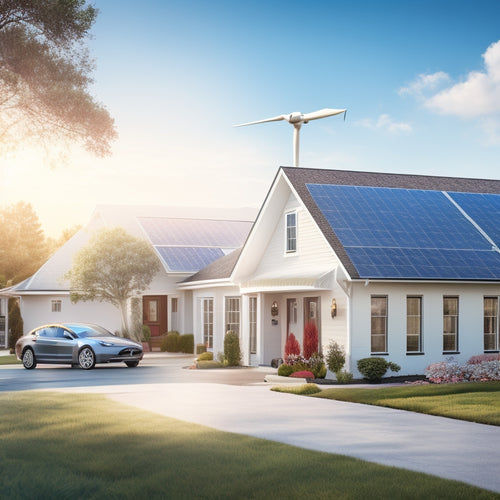
A Beginner's Guide to Installing Solar Panels on My House
Share
As you prepare to utilize the power of solar energy, understanding the key factors that influence a successful installation is vital, starting with a thorough assessment of your property's solar potential, energy needs, and local regulations. You'll need to evaluate your roof's condition, orientation, and shading, as well as your daily energy usage and consumption patterns. Choosing the right solar panels, understanding local building codes, and selecting a reputable installer are also fundamental steps. By considering these factors, you'll be well on your way to a successful solar panel installation that meets your energy needs and budget - and there's more to investigate to guarantee a seamless shift to renewable energy.
Key Takeaways
- Assess your property's solar potential by evaluating solar irradiance, roof size, orientation, and shading to determine feasibility.
- Prepare your roof for installation by inspecting its condition, ensuring compatibility with solar panels, and calculating the optimal installation angle.
- Calculate your daily power requirements by analyzing past utility bills, identifying energy usage trends, and evaluating appliance consumption patterns.
- Choose the right solar panels by considering types, efficiency, budget, and lifespan, and verifying manufacturers' claims and certifications.
- Research local regulations, comply with building codes, and understand net metering policies to ensure a smooth installation process.
Determining Solar Panel Feasibility
Determining Solar Panel Feasibility
Assess your property's solar potential by evaluating its solar irradiance, roof size, and orientation. This site assessment will help you determine how much energy your solar panels can generate.
Consider the roof's pitch, size, and shape, as well as any obstructions that may cast shade. A shading analysis will reveal any potential issues.
Next, consider your local climate and how it affects your energy output. If you live in an area with frequent cloud cover, your energy production may be lower.
You'll also need to evaluate your grid connection options and energy storage needs. Check if your utility company allows grid connection and if there are any specific requirements.
Before installing solar panels, verify you have the necessary installation permits.
Additionally, consider the environmental impact of your installation. Will you need to remove any trees or vegetation to accommodate the panels?
Assessing Your Energy Needs
You'll need to assess your energy needs to determine the size of the solar panel system you require.
Start by examining your current energy usage, including your daily power requirements and energy consumption patterns.
Current Energy Usage
Your household's energy usage serves as the foundation for determining the size and number of solar panels required to meet your needs. To accurately assess your energy needs, you'll need to understand your current energy usage patterns.
Start by reviewing your past utility bills to identify your energy usage trends. Look for patterns in your energy consumption, such as peak usage periods during the summer or winter months.
Identify the different energy sources you currently rely on, such as electricity, natural gas, or propane. This will help you determine which energy sources you can realistically replace with solar power.
Take note of your total energy consumption in kilowatt-hours (kWh) and your average daily energy usage. This information will be essential in determining the size of the solar panel system you need to install.
Daily Power Requirements
Now that you've gained understanding into your household's energy usage patterns, it's time to assess your daily power requirements. This step is essential in determining the size of the solar panel system you'll need to install.
To accurately assess your daily power requirements, you'll need to calculate your total daily energy consumption in watt-hours (Wh).
Here are some key factors to evaluate:
-
Appliances and lighting: Calculate the total energy consumption of your appliances, lighting, and electronics. Evaluate the wattage and usage hours of each item.
-
Energy efficiency: Identify areas where you can improve energy efficiency, such as replacing incandescent bulbs with LEDs or using energy-efficient appliances.
-
Power monitoring: Think about installing a power monitoring system to track your energy consumption in real-time. This will help you identify patterns and opportunities for energy savings.
- Peak usage hours: Determine your peak usage hours, such as morning and evening, when energy consumption is typically highest. This will help you size your solar panel system to meet your energy needs during these periods.
Energy Consumption Patterns
Frequently, households exhibit unique energy consumption patterns that can greatly impact the effectiveness of a solar panel system. To optimize your solar panel installation, it's crucial to assess your energy needs.
You'll want to identify your energy consumption trends, including peak usage hours and days. For instance, if you have a family that's home during the day, your energy consumption will be higher than someone who's away from home for most of the day.
Understanding your energy consumption patterns will help you determine the right size of your solar panel system. You'll want to evaluate factors like energy efficiency, insulation, and the number of energy-hungry appliances in your home.
Choosing the Right Solar Panels
When choosing the right solar panels for your installation, you'll want to contemplate panel efficiency ratings, which measure how well a panel converts sunlight into electricity.
You'll also need to decide on the type of solar cells that best fit your needs, with options ranging from monocrystalline to thin-film cells.
Panel Efficiency Ratings
Efficiency ratings play an important role in choosing the right solar panels for your installation. You want to make certain you're getting the most out of your investment, and efficiency is a key factor in determining the performance of your solar panel system.
When comparing panel types, you'll notice that efficiency ratings vary greatly. Here are some key points to take into account:
-
Higher efficiency doesn't always mean better: While higher efficiency panels may produce more power per hour of sunlight, they're often more expensive. You need to weigh the cost against the potential benefits.
-
Efficiency comparison is vital: Look for panels with high efficiencies (above 20%) if you have limited roof space or want to maximize energy production.
-
Temperature coefficient affects efficiency: Panels with lower temperature coefficients perform better in hot climates, guaranteeing you get consistent energy production throughout the year.
- Manufacturers' claims may vary: Be sure to check the manufacturer's specifications and certifications to confirm the claimed efficiency ratings are accurate.
Types of Solar Cells
You've considered panel efficiency ratings, now it's time to investigate the types of solar cells that make up your panels. There are three primary types: monocrystalline, polycrystalline, and thin film technology.
Monocrystalline panels boast the highest solar cell efficiency, but are also the most expensive. Polycrystalline panels, on the other hand, offer a more affordable option with slightly lower efficiency. Thin film technology is the least efficient but has a lower environmental impact due to its simpler manufacturing process.
Bifacial solar cells are another option, capable of utilizing energy from both the front and back sides of the panel. While they're more expensive, they can increase energy output by up to 25%.
When choosing between these options, consider your budget, desired solar panel lifespan, and installation methods. Monocrystalline panels, for example, may be more suitable for smaller roofs with limited space.
Ultimately, selecting the right type of solar cells will depend on your specific needs and goals. By evaluating the pros and cons of each, you'll be able to make an informed decision and maximize your solar panel investment.
Understanding Local Building Codes
Researching local building codes is an essential step in the solar panel installation process, as it guarantees your system meets the necessary safety and performance standards.
You'll want to verify your solar panel system complies with local regulations to avoid any potential issues or fines.
When researching local building codes, consider the following factors:
-
Zoning regulations: Verify that your property is zoned for solar panel installations and that there are no restrictions on the size or type of system you can install.
-
Permit requirements: Determine what permits are needed to install your solar panel system, and make certain you understand the application and inspection process.
-
Electrical and fire safety codes: Familiarize yourself with local electrical and fire safety codes to confirm your system meets the necessary standards.
- Net metering policies: Check if your local utility company has any specific policies or regulations regarding net metering, which allows you to sell excess energy back to the grid.
Preparing Your Roof for Installation
With local building codes squared away, it's time to focus on your roof, which will soon become a hub of clean energy production. Now, you need to assess your roof's condition and structural integrity to verify it can support the weight of solar panels.
| Roof Considerations | Action Items |
|---|---|
| Roof Condition | Inspect for damaged, missing, or loose shingles, and repair/replace as needed |
| Roof Materials | Confirm materials are compatible with solar panels (e.g., asphalt shingles, metal roofing) |
| Roof Orientation | Determine if your roof receives sufficient sunlight, considering nearby shading obstructions |
| Installation Angle | Calculate the ideal angle for maximum energy production, based on your roof's pitch and local weather patterns |
Considering these factors will help you prepare your roof for a successful solar panel installation. You'll also want to think about future expansions, in case you decide to add more panels later. Remember to account for weather considerations, such as high winds or heavy snow loads, to verify your solar panels are securely fastened. By doing your due diligence now, you'll be well on your way to utilizing the power of the sun.
Selecting a Reputable Installer
Now that your roof is ready for solar panels, it's crucial to find a reputable installer who can guarantee a seamless and efficient installation process.
You'll want to research and vet potential installers to ascertain you're getting high-quality workmanship and equipment.
Here are some key factors to assess when selecting an installer:
-
Installer certifications: Look for certifications from organizations like the North American Board of Certified Energy Practitioners (NABCEP) or the International Association of Electrical Inspectors (IAEI). These certifications demonstrate an installer's proficiency and knowledge of local building codes and regulations.
-
Customer reviews: Check online review platforms like Yelp, Google, or Angie's List to see what previous customers have to say about their experience with the installer. Pay attention to ratings, comments, and any red flags.
-
Experience with similar projects: Ask potential installers about their experience with projects similar to yours, including the type and size of solar panel systems they've installed.
- Warranty and support: Find out what kind of warranty and support the installer offers, including maintenance and repair services.
Understanding Solar Panel Costs
You've narrowed down your search to a reputable installer who can deliver a high-quality solar panel system.
Now, it's important to understand the costs involved. Solar pricing trends have been declining over the years, making it more affordable for homeowners like you to switch to renewable energy. The total installation expenses depend on several factors, including the system size, panel quality, and installation complexity.
On average, the cost of solar panels ranges from $2.50 to $3.50 per watt. For a typical residential system, this translates to $15,000 to $25,000.
However, with the increasing adoption of solar energy, manufacturers are offering more efficient and affordable panels, driving down the costs. Your installer will assess your energy needs and provide a detailed breakdown of the installation expenses, including the cost of equipment, labor, and permits.
It's vital to carefully review the quote and ask questions about any additional costs or fees.
Incentives and Financing Options
As you weigh the costs of going solar, it's essential to investigate the incentives and financing options available to you.
The good news is that there are several government incentives and financing options that can help make solar energy more affordable.
Some of the incentives and financing options you may be eligible for include:
-
Tax credits: Claim a tax credit of up to 26% of the total cost of your solar panel system.
-
Rebate programs: Take advantage of state and local rebate programs that offer cash back for installing solar panels.
-
Energy loans: Secure a low-interest loan to finance your solar panel system, often with repayment terms that can be spread over several years.
- Leasing agreements and power purchase agreements: Partner with a solar company to lease your roof space or purchase electricity at a fixed rate, reducing your upfront costs.
Maintaining Your Solar Panel System
With your solar panel system installed and financed, it's time to focus on ensuring it operates at peak performance. Regular maintenance is essential to maximize energy production and extend the lifespan of your system.
You'll want to perform routine panel cleaning to remove dirt, debris, and other obstructions that can reduce energy output. Cleaning your panels every 6-12 months can increase energy production by up to 25%.
You'll also want to invest in performance monitoring software to track your system's energy output and identify any potential issues. This will enable you to detect and address problems promptly, preventing energy loss and reducing downtime.
Many solar panel manufacturers offer monitoring services that provide real-time data and alerts for system malfunctions. By staying on top of maintenance, you'll be able to enjoy the full benefits of your solar panel system and rest assured that you're doing your part for the environment.
Frequently Asked Questions
Can I Install Solar Panels on a Rented Property?
You'll need to review your renter agreements and discuss solar incentives with your landlord before installing solar panels on a rented property, ensuring you're both on the same page and can benefit from the advantages of clean energy.
Do Solar Panels Work During a Power Outage?
You're wondering if solar panels work during a power outage. The answer is no, unless you have a battery backup system. Since your solar panel efficiency is tied to the grid connection, it's shut off during outages for safety reasons, but with a backup, you'll stay powered up.
Can I Add More Panels to My System Later?
Expanding your solar system is like adding a new chapter to a book - it's a natural progression. You can add more panels later, but consider system expansion and installation considerations, like inverter capacity and roof space, to guarantee a seamless upgrade.
Will Solar Panels Affect My Home's Resale Value?
You'll be pleased to know that solar panels typically increase your home's resale worth, as they're seen as a beneficial, cost-saving upgrade, and with attractive financing options available, you won't break the bank.
Are Solar Panels Resistant to Hail and Extreme Weather?
You'll be relieved to know that solar panels are built to withstand extreme weather conditions, including hail, with durability tested to guarantee peak performance; in fact, most panels can resist hail up to 1 inch in diameter at 50 mph.
Conclusion
You've made it to the finish line, but the real adventure is just beginning. Congrats, you're about to join the ranks of the energy-independent elite! But don't get too comfortable - now you'll have to deal with the envy of your neighbors, the constant barrage of "how's your electric bill?" questions, and the nagging feeling that you should've done this years ago. Welcome to the world of solar-powered smugness.
Related Posts
-

Why You Need a Phone Mount for Navigation
When you're on the road, a reliable phone mount is not just a convenience, it's a safety necessity that helps you mai...
-

What You Need to Know About Permits and Inspections
You need to navigate the complex landscape of permits and inspections to guarantee your project complies with local z...
-

Why Homeowners Are Embracing DIY Energy Independence
By taking control of your energy needs, you're breaking free from the uncertainty of utility bills and embracing a se...


